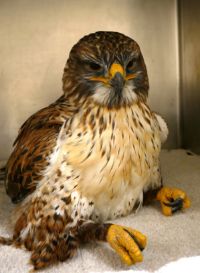Rehabilitation
Injured, sick and orphaned birds come into RMRP in a variety of ways and for a variety of reasons. They arrive with the aid of the general public, wildlife and government officials, and our RMRP staff and volunteers. Most have come to us when they lost in a conflict with humans or with our way of life. These birds are hit by vehicles, collide with windows or power lines, are attacked by cats or dogs or become tangled in barbed wire fencing. Other encounters include contact with high voltage components such as transformers, lead and other poisons, gunshot, leg hold traps, and methane burners. Young birds come to us because they have become prematurely separated from their parents or sometimes they are found on the ground and picked up when they shouldn’t have been. Nests can be destroyed through tree trimming and landscaping activities, construction activities, and natural occurring events such as storms.
Our rehabilitation staff are licensed wildlife rehabilitators with permits from the State of Colorado and the US Fish and Wildlife Service that allow us to do the life saving work that we do. The wonderful veterinarians from the Zoological Medicine service at the Colorado State University Veterinary Teaching Hospital provide veterinary input and assist with tasks we can not accomplish at our facility such as surgeries, radiographs and other diagnostics. RMRP receives and treats approximately 300 of these birds every year and of the treatable birds we release 80% or more back to the wild for a second chance at freedom.

